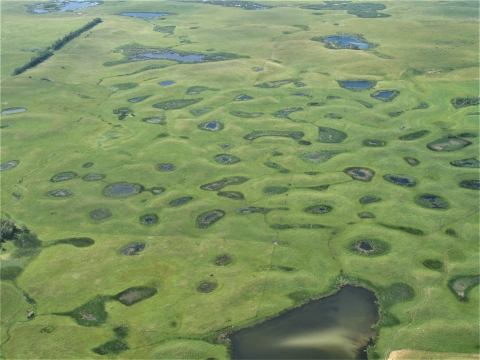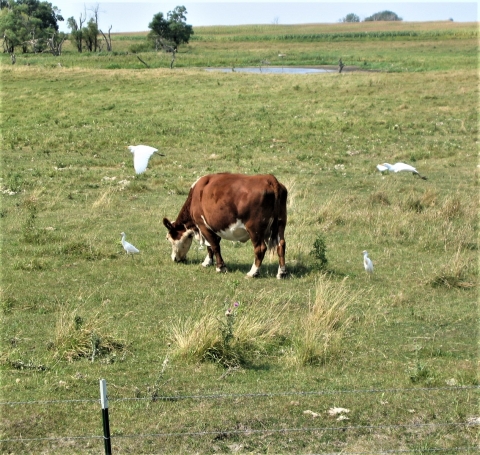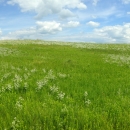What We Do
In the Prairie Pothole Region of the northern Great Plains, private landowners play a critical role in protecting wetlands and grasslands that serve as key migration and breeding habitats for waterfowl and other migratory birds.
Wetland and grassland easements established on private lands help ensure valuable habitats continue to benefit future generations of people and wildlife.
Management and Conservation
Wetland Easements
Wetland easements protect wetland areas from being drained, filled, leveled, or burned. They provide critical habitat for migratory birds and other resident wildlife. Private landowners receive a one-time payment for permanently protecting the wetland area. When they dry up naturally, the wetland area can be farmed, hayed, or grazed.
Why protect wetlands?
Wetlands benefit people and wildlife. By holding water, wetlands reduce erosion, flooding, and runoff. They recharge groundwater supplies and provide hay for livestock in dry years. Wetlands also provide important habitat for many kinds of wildlife, including waterfowl, other migratory birds, pheasants, and deer.
Unfortunately, more than half of the nation’s wetlands have been lost since the 1800s. Protecting existing wetlands benefits people and helps ensure wildlife will be here for future generations to enjoy.
What is a wetland easement?
A wetland easement is a legal agreement signed with the United States of America, through the U.S. Fish and Wildlife Service, that pays you, the landowner, to permanently protect the wetland areas on your property.
Wetland areas covered by an easement cannot be drained, filled, leveled, or burned. When these wetland areas dry up naturally, they can be farmed, hayed, or grazed. Wetland areas covered by an easement are mapped and a copy of the easement and maps are sent to you. No signs are placed on your property.
Does any land qualify for a wetland easement?
No. The property must have wetlands of value to waterfowl and other migratory birds. The land must also be located in a county approved for conservation easements in the Prairie Pothole Region of Montana, North Dakota, and South Dakota.
How much of my land would be covered by the easement?
During the easement application process, Service staff works with you to come up with a mutually agreed upon easement size and location. The wetland areas in the easement are mapped and included as Exhibit A in the easement contract. The easement covers certain existing wetlands or those which recur over time through natural causes. Impoundments by dams or dikes do not qualify. Enforcement of the easement terms is limited to the mapped wetland areas.
What happens with wetlands that have already been drained?
Wetlands already drained are not covered by the provisions of the easement unless the ditch is filled and the wetlands are restored. Funding and technical assistance to complete this work is available through the Service Partners for Fish & Wildlife Program.
How will the easement affect my farming of the protected wetland areas?
The easement imposes no restrictions on farming practices such as grazing, haying, plowing, working, or cropping wetlands when they are dry by natural causes. When you have an established easement, contact the local wetland management district wetland management district
A wetland management district is a U.S. Fish and Wildlife Service office that manages waterfowl production areas in one or more counties. Waterfowl production areas are small natural wetlands and grasslands that provide breeding, resting and nesting habitat for waterfowl, shorebirds, grassland birds and other wildlife. The Fish and Wildlife Service acquires waterfowl production areas under the authority of the Migratory Bird Hunting and Conservation Stamp Act, primarily using funds from the sale of Federal Duck Stamps. The Refuge System’s 38 wetland management districts comprise thousands of waterfowl production areas – almost all in the Prairie Pothole Region of the Northern Great Plains.
Learn more about wetland management district manager prior to conducting practices such as tiling, ditching, and pumping that may inadvertently drain a protected wetland area.
Will the easement affect hunting and trapping rights on my land?
No. Hunting and trapping rights are not affected by the easement.
Will the easement affect my mineral rights?
No. Subsurface rights are not affected by the easement. Still, remember that the easement prohibits burning, draining, filling, and leveling of the wetland areas. Contact the local District manager prior to conducting activities that may inadvertently result in non-compliance with the easement.
Grassland Easements
Grassland easements protect both large and small tracts of grass from conversion. They provide critical habitat for migratory birds and other resident wildlife. Private landowners receive a one-time payment for permanently protecting grasslands. After July 15 of each year, the grassland easement may be hayed, mowed, and harvested for grass seed. Grazing is not restricted in any way.
Why protect grasslands?
Grasslands help reduce soil erosion caused by wind and water. They also filter chemicals, thus protecting water supplies. Vegetation such as grass, wildflowers, and shrubs also help trap snow and rain, allowing water to seep into the soil, thereby recharging groundwater. Grasslands also provide forage for livestock. Many wildlife species depend on grasslands for food, shelter, and nesting sites.
Over time, settlement, agriculture, and development have reduced and fragmented the grasslands of North America. Protecting grasslands benefits people and helps ensure that wildlife will be here for future generations to enjoy.
What is a grassland easement?
A grassland easement is a legal agreement signed with the United States of America, through the U.S. Fish and Wildlife Service, that pays landowners to permanently keep their land in grass.
Land protected by a grassland easement may not be cultivated. Haying and mowing must be delayed until after July 15 each year. These restrictions help grassland-nesting species, such as ducks and pheasants, complete their nesting cycle. Grazing is not restricted in any way. No signs are placed on your property.
Does any land qualify for a grassland easement?
No. To qualify for the easement program, property must be located in a county which has been approved for conservation easements and have value to waterfowl and grassland birds. Highest priority lands include large tracts of grass with high wetland densities, native prairie, or lands most likely to be converted to cropland.
What about farm sites, feedlots, etc.?
Existing farm sites and feedlots are excluded from grassland easements. Also, during the easement process, Service staff works with you to exclude any areas that may be developed in the future.
Will a grassland easement affect my eligibility in U.S. Department of Agriculture (USDA) farm programs?
The easement may limit participation in USDA programs where base acres of cropland are used to determine program eligibility, such as enrollment in the Conservation Reserve Program. Contact your local Farm Service Agency for information regarding eligibility.
How will the grassland easement affect my farming of the protected grasslands?
Farming or cropping is not allowed. Grazing is allowed anytime.
Haying is allowed after July 15 of each year. This gives grassland-nesting wildlife species the opportunity to complete their nesting cycle.
Who controls noxious weeds and pests?
As the landowner, you are responsible for noxious weed and pest control, in accordance with state and local laws. In addition, mowing before July 15 to control weeds is prohibited unless you have prior written approval by the Service.
Will the easement affect hunting and trapping rights on my land?
No. Hunting and trapping rights are not affected by the easement.
Will the easement affect my mineral rights?
No. Subsurface rights are not affected by the easement. Contact the local District manager prior to conducting activities that may inadvertently result in non-compliance with the easement.
Who should I contact with additional questions?
Contact the District office in which your land is located.
FAQs
Is this a voluntary program?
Yes. The U.S. Fish and Wildlife Service (Service) enters into conservation easements only with interested landowners.
How long does the easement last?
This is a permanent (perpetual) easement between the Service and the landowner. If the property is sold, the easement transfers to the new landowner.
What does it mean that the easements are “limited-interest?”
A limited-interest easement entitles the Service to purchase a limited set of rights on privately owned land. With wetland easements, the wetland areas cannot be drained, filled, leveled, or burned. With grassland easements, the grasslands cannot be cultivated, and haying is restricted until after July 15 of every year.
Are Service wetland and grassland easements managed in the same way as conservation programs managed by the Natural Resources Conservation Service (NRCS)?
No. NRCS programs are managed by the U.S. Department of Agriculture and may have different objectives and conservation strategies. Contact the Service wetland management district office in which your land is located for more information. Contacts can be found in the menu on the left.
Easement Application and Acceptance Process
How do I begin the process?
Contact the District office in which your land is located. A Service easement specialist or realty specialist will provide more information about the program and answer any questions you may have. If you are interested, an evaluation of your property will be scheduled to determine if it qualifies.
What happens before the easement is accepted?
The Service obtains title information from the abstractor at no cost to you. The title is checked to determine if all owners of record have signed the easement and for liens, judgments, and mortgages on the property. Service attorneys review the case and furnish an opinion of title. If the opinion indicates any title defects, the Service will assist you in correcting them before accepting the easement. The process usually takes about 6 to 9 months.
What happens after the easement is accepted?
You will receive a letter by certified mail informing you that the easement has been accepted and is being recorded at the county courthouse. At that time, the Service will also send you a copy of the fully executed easement.
Financial Aspects
What are the financial benefits of entering the easement program?
When the Service acquires an easement, you, as the landowner, receive a one-time payment.
How is the payment amount determined?
A Service realty specialist will estimate the value of the easement based upon current land sales, assessed values, other indicators of land value relevant to your property, and in compliance with Service policy. You will be provided a written offer in a document called a “Statement of Just Compensation.” The Statement of Just Compensation will describe the property encumbered by the easement and the amount of the payment.
What is the payment method?
A single lump-sum payment will be sent to you from the U.S. Treasury or from another authorized entity for the amount specified in the Statement of Just Compensation.
When will I be paid?
Payment is usually made after the easement is accepted and recorded in the county courthouse, usually within 6 to 12 months after the easement was signed by the landowner.
What if I have a mortgage on the property?
In most cases, this will not affect the easement transaction. If it is necessary to have the mortgage holder give consent to the easement, the Service will require the mortgage holder to sign an agreement known as a “Subordination Agreement,” which subordinates the rights of the mortgage to those of the easement.
Who pays for the Subordination Agreement?
If there is a charge, you will need to pay for it and then file a claim for reimbursement from the Service through the realty specialist. Reimbursement will occur at the same time as easement payment.
Will I pay income taxes on the payment?
You will be issued an IRS Form 1099-S by the Denver Finance Center at the end of the calendar year in which the easement payment is made. The payment should be reported on your Federal income tax return, but it may not be taxable. Consult your tax attorney or accountant for further guidance.
Will I still need to pay property taxes?
You will still pay property taxes assessed by the County or State government. Conveying an easement to the Service will not change your property tax payment, and will not impact the local property tax base.
Easement Administration
Will the Service be monitoring my land after the agreement is recorded?
Yes. The Service is required to monitor conservation easements to ensure the wetland areas and grasslands are intact and continue to provide wildlife benefits. That said, if you are in compliance with the terms of the agreement, you are unlikely to see a Service representative on your land.
How can I ensure I am in compliance with the terms of the easement?
To ensure you are in compliance, contact the District manager before performing any alterations within or near protected wetland areas and grasslands, including tiling land near protected wetland areas.
What if I have problems with my wetland easement?
Contact your local District staff if you have questions or concerns regarding your easement. The District staff will want to discuss your concerns on a one-on-one basis.
What if the quality of the grassland easement deteriorates?
A written permit may be obtained from the District staff to replant or rejuvenate grassland habitat with a previous cropping history. We encourage grasses that are suitable to your needs and the long-term needs of wildlife. Contact your District staff for ideas on rejuvenating grassland habitat that does not have a cropping history.
Cost-sharing or donated seed may be available through Federal, State, or private organizations.
Additional Questions
Who should I contact with additional questions?
Contact the District office in which your land is located.
Our Services
Cooperative Agriculture Opportunities for Grazing on Waterfowl Production Areas
Waubay National Wildlife Refuge and Wetland Management District, Waubay, South Dakota has cooperative agriculture opportunities for grazing on Waterfowl Production Areas in Clark, Codington, Day, Grant, Marshall and Roberts counties for up to five years. Applications may be requested by calling the office at 605-947-4521. To be considered, applicants must complete and submit the bid form/application. Successful applicants will be selected through an open and competitive process. For more information, please contact Refuge Manager.
Law Enforcement
In years past, unlimited harvests could wreak havoc on wildlife populations.
Our law enforcement officers are dedicated to protecting our natural resources and keeping visitors safe. Certain rules and regulations are necessary to insure the well-being of the public and ensure healthy wildlife populations for current and future generations. Observance of these rules will make the Refuge a better place for visitors and the wildlife they come to enjoy. The Refuge is also subject to Federal, State and local laws and regulations.
Information about hunting and fishing can be found under Visitor Activities and Rules and Regulations.




